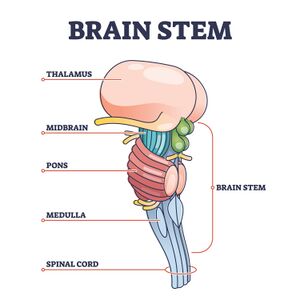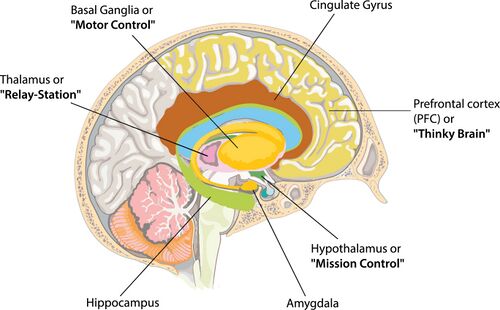Thalamus: Difference between revisions
No edit summary |
No edit summary |
||
| Line 10: | Line 10: | ||
* The thalamus also functions to relay information from the [[brainstem]] to the cortex, coordinating shifts in consciousness such as waking up and falling asleep<ref name=":0">Halassa, M.M., Kastner, S. Thalamic functions in distributed cognitive control. ''Nat Neurosci, 2017;'' 20, 1669–1679. </ref> | * The thalamus also functions to relay information from the [[brainstem]] to the cortex, coordinating shifts in consciousness such as waking up and falling asleep<ref name=":0">Halassa, M.M., Kastner, S. Thalamic functions in distributed cognitive control. ''Nat Neurosci, 2017;'' 20, 1669–1679. </ref> | ||
The thalamus can be divided into approximately 60 regions known as '''thalamic nuclei'''. Each nucleus has unique pathways as inputs and various projections as outputs, most of which send information to the '''[[Cerebral Cortex|cerebral cortex]]'''.<ref name=":1">Torrico TJ, Munakomi S. Neuroanatomy, Thalamus. [Updated 2023 Jul 24]. In: StatPearls [Internet].</ref> | The thalamus can be divided into approximately 60 regions known as '''thalamic nuclei'''. Each nucleus has unique pathways as inputs and various projections as outputs, most of which send information to the '''[[Cerebral Cortex|cerebral cortex]]'''.<ref name=":1">Torrico TJ, Munakomi S. [https://www.ncbi.nlm.nih.gov/books/NBK542184/ Neuroanatomy, Thalamus]. [Updated 2023 Jul 24]. In: StatPearls [Internet].</ref> | ||
=== | === Hypothalamus === | ||
* Located inferior to the thalamus | * Located inferior to the thalamus | ||
| Line 20: | Line 20: | ||
The hypothalamus plays a major role in maintaining homeostasis via the autonomic nervous system, the neuroendocrine system, and the limbic system. It regulates emotions, hormone production from the pituitary gland, and body functions such as appetite, body temperature, reproduction, and circadian rhythms. | The hypothalamus plays a major role in maintaining homeostasis via the autonomic nervous system, the neuroendocrine system, and the limbic system. It regulates emotions, hormone production from the pituitary gland, and body functions such as appetite, body temperature, reproduction, and circadian rhythms. | ||
=== | === Epithalamus === | ||
* Located behind the thalamus | * Located behind the thalamus | ||
| Line 31: | Line 31: | ||
== Thalamic Function == | == Thalamic Function == | ||
[[File:Brain cross section with subcortical structures.jpeg|thumb|500x500px|Note the central location of the thalamus in relation to other subcortical structures and the cerebral cortex.]] | [[File:Brain cross section with subcortical structures.jpeg|thumb|500x500px|Note the central location of the thalamus in relation to other subcortical structures and the cerebral cortex.]]The thalamus receives and processes sensory information from the body, before transmitting this information to the relevant cortical area.<ref name=":1" /> | ||
The thalamus receives and processes sensory information from the body, before transmitting this information to the relevant cortical area.<ref name=":1" /> | |||
* The thalamus has many connections with the cerebral cortex, which are known as '''thalamacortical loops''' | * The thalamus has many connections with the cerebral cortex, which are known as '''thalamacortical loops''' | ||
* The thalamus also modulates arousal mechanisms, maintains alertness, and directs attention to sensory events<ref name=":0" /> | * The thalamus also modulates arousal mechanisms, maintains alertness, and directs attention to sensory events<ref name=":0" /> | ||
* The thalamus also has connections with a number of structures of the [[Limbic System|limbic system]], including the hippocampus, mammillary bodies, and fornix, so it has a role in learning and episodic memory<ref name=":1" /> | |||
The thalamus can be divided into five major functional components.<ref name=":1" /> | The thalamus can be divided into five major functional components.<ref name=":1" /> | ||
# '''Reticular and intralaminar nuclei''' | # '''Reticular and intralaminar nuclei''': involved in arousal and pain regulation | ||
# '''Sensory nuclei''' regulate sensory domains, apart from olfaction | # '''Sensory nuclei''': regulate sensory domains, apart from olfaction | ||
# '''Effector nuclei''' govern | # '''Effector nuclei''': govern motor and language functions | ||
# '''Associative nuclei''' involved in cognitive functions | # '''Associative nuclei''': involved in cognitive functions | ||
# '''Limbic nuclei''' | # '''Limbic nuclei:''' manageg mood and motivation | ||
These specific nuclei | These specific nuclei help to scan the cerebral cortex and to determine active brain regions, relaying this information to the rest of the thalamus.<ref name=":0" /> | ||
== Thalamus and Injury == | == Thalamus and Injury == | ||
Revision as of 02:36, 18 June 2024
Original Editor - Lucinda hampton
Top Contributors - Lucinda hampton, Jess Bell, Stacy Schiurring, Kirenga Bamurange Liliane, Mason Trauger, Uchechukwu Chukwuemeka, Vidya Acharya and Rucha Gadgil
Thalamus Structure[edit | edit source]
The thalamus functions as a relay station between the brain and the body, filtering through various types of sensory and motor information.
The thalamus is located medial to the cerebrum and consists of two oval-shaped masses connected by the intermediate mass. Each mass consists of several groups of nuclei that serve different functions. Motor and sensory pathways (with the exception of olfaction) pass through this central structure.
- The thalamus transmits 98 percent of sensory information to the cortex, including vision, taste, touch and balance
- The thalamus also conducts motor signals from the cerebral cortex to the spinal cord and ultimately to the peripheral nervous system
- The thalamus also functions to relay information from the brainstem to the cortex, coordinating shifts in consciousness such as waking up and falling asleep[1]
The thalamus can be divided into approximately 60 regions known as thalamic nuclei. Each nucleus has unique pathways as inputs and various projections as outputs, most of which send information to the cerebral cortex.[2]
Hypothalamus[edit | edit source]
- Located inferior to the thalamus
- Two rounded eminences protrude from the back, called mammillary bodies
- Anteriorly, the hypothalamus is connected to the pituitary gland by a long stalk called the infundibulum, also known as the pituitary stalk
The hypothalamus plays a major role in maintaining homeostasis via the autonomic nervous system, the neuroendocrine system, and the limbic system. It regulates emotions, hormone production from the pituitary gland, and body functions such as appetite, body temperature, reproduction, and circadian rhythms.
Epithalamus[edit | edit source]
- Located behind the thalamus
- Includes the pineal gland, which secretes the hormone melatonin in response to darkness, regulating our circadian rhythms and sleep-wake cycles
The Subthalamus[edit | edit source]
- Located beneath the thalamus
- Includes the subthalamic nucleus, which is functionally considered part of the basal ganglia
Thalamic Function[edit | edit source]
The thalamus receives and processes sensory information from the body, before transmitting this information to the relevant cortical area.[2]
- The thalamus has many connections with the cerebral cortex, which are known as thalamacortical loops
- The thalamus also modulates arousal mechanisms, maintains alertness, and directs attention to sensory events[1]
- The thalamus also has connections with a number of structures of the limbic system, including the hippocampus, mammillary bodies, and fornix, so it has a role in learning and episodic memory[2]
The thalamus can be divided into five major functional components.[2]
- Reticular and intralaminar nuclei: involved in arousal and pain regulation
- Sensory nuclei: regulate sensory domains, apart from olfaction
- Effector nuclei: govern motor and language functions
- Associative nuclei: involved in cognitive functions
- Limbic nuclei: manageg mood and motivation
These specific nuclei help to scan the cerebral cortex and to determine active brain regions, relaying this information to the rest of the thalamus.[1]
Thalamus and Injury[edit | edit source]
The thalamus contributes to a broad range of critical functions therefore injury to the thalamus can present clinical signs and symptoms unique to each individual.
Some of the most common symptoms of thalamic damage or dysfunction include:
- Sensory issues such as tingling, numbness, hypersensitivity, and pain
- Vision loss or light sensitivity
- Motor impairments
- Tremors
- Attention problems
- Memory loss
- Insomnia
- Impairments to proprioception
Additional presentations unique to thalamic injury involve:
- Thalamic pain syndrome: an excruciating sensation of pain unresponsive to narcotics. Once called Dejerine-Roussy Syndrome, this condition is commonly associated with infarct affecting the ventroposterolateral thalamus [3] [4].
- Pusher Syndrome (also referred to as "persons who push"): a lesion to the posterior thalamus interrupts a connection to the vestibular nuclei, leading to lateropulsion in the direction of the impaired side. [5]
- Vegetative state and coma: a lesion to the non-specific (intralaminar and reticular) nuclei. [6] Coma may occur due to the thalamus's impacts on sleep and arousal.
Physiotherapy Treatment[edit | edit source]
Treatment for thalamic damage will revolve around restoring the abilities lost after brain injury. Treatment is symptom specific, therefore thorough and ongoing therapy assessment is required for proper management and treatment.
For more information, please read the following articles:
- Traumatic Brain Injury
- Traumatic Brain Injury Clinical Guidelines
- Physiotherapy Management of Traumatic Brain Injury
- Physical Activity Guidelines for Traumatic Brain Injury
- Stroke: The Role of Physical Activity
- Stroke: Clinical Guidelines
- Post-Stroke Pain
- Mirror Therapy
- Management of pushing tendencies
- Desensitization treatment for thalamic pain
References[edit | edit source]
- ↑ 1.0 1.1 1.2 Halassa, M.M., Kastner, S. Thalamic functions in distributed cognitive control. Nat Neurosci, 2017; 20, 1669–1679.
- ↑ 2.0 2.1 2.2 2.3 Torrico TJ, Munakomi S. Neuroanatomy, Thalamus. [Updated 2023 Jul 24]. In: StatPearls [Internet].
- ↑ Jahngir MU, Qureshi AI. Dejerine roussy syndrome. 2023.In: StatPearls [Internet].
- ↑ Dydyk AM, Munakomi S. Thalamic Pain Syndrome.[Updated 2023 Aug 13]. StatPearls [Internet]. Treasure Island (FL): StatPearls Publishing. 2023.
- ↑ Rosenzopf H, Klingbeil J, Wawrzyniak M, Röhrig L, Sperber C, Saur D, Karnath HO. Thalamocortical disconnection involved in pusher syndrome. Brain. 2023;146(9):3648-3661.
- ↑ Adams JH, Graham DI, Jennett B. The neuropathology of the vegetative state after an acute brain insult. Brain. 2000 Jul;123 (Pt 7):1327-38.








